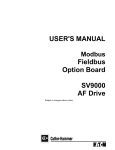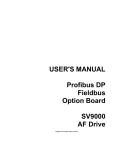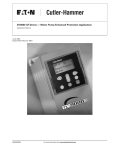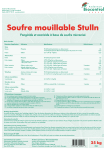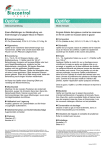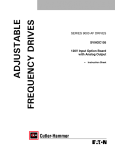Download USER'S MANUAL Option Board SV9000 AF Drive
Transcript
USER'S MANUAL LONWORKS Option Board ® SV9000 AF Drive Subject to changes without notice ® SV9000 LONWORKS Option Board manual Page 1 _________________________________________________________________________________________ INDEX 1. INTRODUCTION................................................................................................................................................. 2 1.1 General........................................................................................................................................................... 2 1.2 About this manual........................................................................................................................................... 2 1.3 Safety Precautions ......................................................................................................................................... 2 2. SPECIFICATIONS .............................................................................................................................................. 3 ® 3. LONWORKS ..................................................................................................................................................... 4 3.1 Overview......................................................................................................................................................... 4 3.2 Physical media and wiring .............................................................................................................................. 4 3.3 Bus termination .............................................................................................................................................. 5 3.4 Service button and LED.................................................................................................................................. 6 4. INSTALLATION .................................................................................................................................................. 7 5. CONNECTIONS .................................................................................................................................................. 9 5.1 Board layout ................................................................................................................................................... 9 5.2 I/O-control connections ................................................................................................................................ 10 6. COMMISSIONING ............................................................................................................................................ 11 ® 7. SV9000 LONWORKS INTERFACE ................................................................................................................ 12 7.1 Network Variables ........................................................................................................................................ 12 7.1.1 Network Input variables in the SV9000 ................................................................................................ 12 7.1.2 Network Output variables from the SV9000......................................................................................... 13 7.1.3 Network Configuration variables to the SV9000................................................................................... 15 Echelon, LonTalk, LONW ORKS, LONMARK, Neuron and 3120 are trademarks of Echelon Corporation registered in the United States and other countries. _________________________________________________________________________________________ Cutler-Hammer ® SV9000 LONWORKS Option Board manual Page 2 _________________________________________________________________________________________ 1. INTRODUCTION 1.1 General ® SV9000 drives can be connected to a LONW ORKS network using the SV9NCLCN option board kit. The ® drive can then be controlled, monitored and programmed from the LONW ORKS network. The LonWorks® option board can also extend the used I/O: x 4 digital inputs (standard signals) x 4 digital outputs (standard signals) x thermistor input (can be directly connected to the motor thermistors for overtemperature trip) x Encoder input The interface board must be installed in the external option enclosure outside the drive. 1.2 About this manual The purpose of this manual is to provide you with the information how to install and set up your SV9000 ® ® LONW ORKS Option Board for communication over a LONW ORKS network. For more specific information on installation and operation of the SV9000 refer to the SV9000 Drive User’s Manual and SV9000 Fieldbus Application User’s Manual. ® This manual assumes that you are familiar with the SV9000 drive and are using the LONW ORKS Option Board with a SV9000 drive using the application for fieldbus support. It is also assumed that you are ® familiar with LONW ORKS and its installation procedures and tools. 1.3 Safety Precautions Before starting the installation, carefully read all warnings and safety instructions in the SV9000 Drive User’s Manual. Internal components and circuit boards (except the isolated I/O terminals) are at utility potential when the SV9000 is connected to the utility. This voltage is extremely dangerous and may cause death or severe injury if you come in contact with it. The control I/O terminals are isolated from the utility potential, but the I/Os (if jumper X9 is in OFF-position) may have a dangerous voltage connected even if the power is off on SV9000. _________________________________________________________________________________________ Cutler-Hammer ® SV9000 LONWORKS Option Board manual Page 3 _________________________________________________________________________________________ SPECIFICATIONS Bus Interface Channel FTT-10A Free Topology transceiver connections Transfer cable Twisted pair I/O -control Digital input (4 pcs) 24 V (r 15 %), Ri = 5 k: connections Digital output (4 pcs) Open collector output, 50 mA/48 V thermistor input (1 pcs) Rtrip = 4.7 k: Encoder input (3 pcs) 24 V (r 30 V): “0” d10 V, “1” t18 V, Ri = 3.3 k: 5 V (r 10 V): “0” d2 V, “1” t3 V, Ri = 330 : Aux. voltage Safety 24 V (r20%), max 50 mA Fulfills EN50178 standard Table 1-1. Specifications The control connections are isolated from the utility potential and the I/O ground is connected to the frame of the device via a 1 M: resistor and a 4.7 nF capacitor*. The control I/O ground can also be connected directly to the frame by changing the position of jumper X9 (GND ON/OFF) to the ONposition. Digital inputs are isolated from the I/O ground. * Default value (X9 is in the GND OFF- position) _________________________________________________________________________________________ Cutler-Hammer ® SV9000 LONWORKS Option Board manual Page 4 _________________________________________________________________________________________ 2. LonWorks® 2.1 Overview ® Echelon Corporation has developed LonWorks® technology. LONW ORKS network is used for applications in industry and building automation, controlling household electronics, medical ® instrumentation and many others. The goal of the LONW ORKS network is to provide a common vendor independent communication network for intelligent devices. ® In a LONW ORKS network, no central control or master-slave architecture is needed. Nodes on a ® network communicate with each other using the LonTalk protocol. Interoperable nodes use Standard Network Variable Types (SNVT) for communicating over the network. The definition of ® an SNVT includes units, a range, and an increment. SV9000 LONW ORKS uses only Standard Network Variable Types as data types. All network variables are either input (data comes from the network to the device) or output (data is sent to the network from the device) network variables. When network variables on different nodes on the network have been bound together by an installation tool, passing of data is automatic between the right nodes. Only the same type of network variables can be bound together, so it is very important to have compatible interfaces. 2.2 Physical media and wiring ® LONW ORKS networks can be implemented on many different physical media. SV9000 SV9NCLW option board is equipped with an FTT-10A transceiver supporting the Free Topology transformer coupled network, which allows the network wire to be connected as bus, star, loop or mixed. Communication speed with this media is 78kBits/s. The FTT-10A transceiver is compatible with Echelon’s LPT-10 Link Power Transceiver, and these transceivers can communicate with each other on a single twisted pair cable. termination termination Figure 2-1 Doubly Terminated Bus Topology termination Figure 2-2 Singly Terminated Bus Topology _________________________________________________________________________________________ Cutler-Hammer ® SV9000 LONWORKS Option Board manual Page 5 _________________________________________________________________________________________ termination Figure 2-3 Star Topology termination Figure 2-4 Loop Topology Up to 64 FTT-10 transceiver nodes are allowed per network segment, the individual segments can be connected together by a router. See table 3-1 for recommended cable types and cable lengths for FTT10. Even though unshielded cable types are recommended to be used with this type of transceiver, it is still highly recommended to use only shielded cables with drives. Attention should be paid to proper grounding of the shield to ensure bus operation, grounding of the shield should be done on both ends of the cable. Cable type Max. doubly terminated bus length Max. free topology wire length Max. node-tonode distance Belden 85102 (unshielded) 2700 m 500 m 500 m Belden 8471 (unshielded) 2700 m 500 m 400 m Level IV, 22AWG (unshielded) 1400 m 500 m 400 m JY (St) Y 2x2x0.8mm (shielded) 900 m 500 m 320 m Table 2-1 FTT-10 wiring 2.3 Bus termination The FTT-10 network segment requires termination for proper data transmission performance. A total termination impedance of approximately 52.3: is required. In a free topology segment, only one termination is required and may be placed anywhere on the free topology segment. In a doubly terminated bus topology, two terminations are required, one at each end of the bus. The SV9000 SV9NCLW option board is equipped with termination resistors, which can be selected by jumper X6. If the jumper is in the ‘ST’ position single termination is selected and if it is in ‘DT’ double termination is selected. If termination is not done at this node the jumper should be removed or positioned so that it is connected to one pin only. _________________________________________________________________________________________ Cutler-Hammer ® SV9000 LONWORKS Option Board manual Page 6 _________________________________________________________________________________________ 2.4 Service button and LED ® Every LONW ORKS device has a service button, which is needed during network installation. Pressing the button causes the node to send its unique ID number to the network. Because the SV9000 ® LONW ORKS Option Board is located under drive’s cover in normal use, the service button operation can be done by changing the value of a service button parameter from 0 to 1 or vice versa on the SV9000 operating panel. The location of the service button parameter depends on the used SV9000 application. ® Each LONW ORKS device should also have a service LED on it. The LED shows the operating state of the device by blinking. On SV9000 the operating state can be seen on the operating panel as actual value 22. See table 3-2 for coding of the states. Node State State Code Service LED Applicationless and Unconfigured 3 On Unconfigured 2 Flashing Configured 4 Off Table 2-1 Service LED states _________________________________________________________________________________________ Cutler-Hammer ® SV9000 LONWORKS Option Board manual Page 7 _________________________________________________________________________________________ 3. INSTALLATION Before starting the installation, carefully read the safety instructions in the " SV9000 Drive User's ® Manual" chapter “SAFETY”. Check that you have recieved all the LONW ORKS kit parts: Repeater board ® on mounting board, power cable (black terminal), data cable (blue terminal) and LONW ORKS board in the separate option enclosure. Repeater board with mounting board can be installed in the existing option board place inside the drive (see figure 4-1). A Remove the control panel and the jumper X4 from the control board. Install the jumper that you removed from terminal X4 of the control board, on terminal X9 of the Fieldbus board in the ON or OFF position. B Connect the power cable to terminal X5 of the control board and the data cable to terminal X14. The power cable can also be connected to terminal X6 if the power cable from the power board is connected to terminal X5. C Put the data and power cables through the holes in the mounting board. D Install the mounting board on the standoffs by the larger holes and push it into the right position in the slots on the standoffs . Check that the mounting board is stable and secure it with a screw to the lower left standoff. If you have difficulties to place the board, slightly bend regulator A4 and capacitor C59 of the control board. E Connect the power cable to terminal X1 of the Repeater board and the data cable to terminal X2. F Connect the cable coming out of the option enclosure to terminal X3 of the repeater board. Find the closest grounding terminal on the drive and strip the cable so that you can ground the shield under the grounding terminal. G After this install the control panel back in its place. H If you use a 5 V encoder input, install the jumper in terminal X7 (see figure 5-1) of the ® LONW ORKS board _________________________________________________________________________________________ Cutler-Hammer ® SV9000 LONWORKS Option Board manual Page 8 _________________________________________________________________________________________ X2 X1 X3 X14 X5 Figure 3-1. Repeater board on mounting board installed on top of the control board _________________________________________________________________________________________ Cutler-Hammer ® SV9000 LONWORKS Option Board manual Page 9 _________________________________________________________________________________________ 4. CONNECTIONS 4.1 Board layout X10 Terminals: X11 X5 X10 X11 I/O - terminals thermistor input X5 LONW ORKS network ® service power ® Figure 4-1. LONWORKS option board Diagnostic LED: power Supply Voltage, Green. Power led is active if the interface board has supply voltage. service Neuron’s service pin, Green. See table 3-2. for operation of this led. _________________________________________________________________________________________ Cutler-Hammer ® SV9000 LONWORKS Option Board manual Page 10 _________________________________________________________________________________________ 4.2 I/O-control connections Terminal 301 DID1 Signal Programmable: External fault Description Contact open = no fault Contact closed = fault OR Encoder Signal from motor thermistor 302 DID2 303 DIE3 304 DIE4 305 306 307 308 309 310 311 312 313 314 315 316 317 318 319 320 327 328 329 330 COMD +24 V COME GND DID5A+ DID5ADID6B+ DID6BDID7Z+ DID7ZGND DOD1 DOD2 DOD3 DOD4 GND TI+ TINET1 NET2 Select of Active Control Source Run disable Acceler. / Decel. time selection Jogging speed selection Common for DID1-DID2 Control voltage output Common for DIE3-DIE4 I/O ground Pulse input A (differential input) Pulse input B (differential input) Pulse input Z (differential input) I/O ground Open collector output 1 Open collector output 2 Open collector output 3 Open collector output 4 I/O ground thermistor input Contact open = SV9000 IO-terminal Contact closed = Fieldbus Contact open = start of motor enabled Contact closed = start of motor disabled Contact open = time 1 selected Contact closed = time 2 selected Contact open = no action Contact closed = jogging speed Connect to GND or +24 V Voltage for switches, etc. max. 0.05 A Connect to GND or +24 V Ground for reference and controls 90 degrees phase shift compared to pulse input A one pulse per one revolution Ground for reference and controls READY RUN FAULT FIELDBUS CONTROL Ground for reference and controls ® LONW ORKS network Figure 4-1. Control connections NOTE! thermistor input(terminals 327 and 328) must be shorted if not used. READY = ON, when the utility voltage has been applied and the SV9000 is ready to operate RUN = ON, when the motor is running FAULT = ON, if a fault occurs _________________________________________________________________________________________ Cutler-Hammer ® SV9000 CX LONWORKS Option Board manual Page 11 _________________________________________________________________________________________ 5. COMMISSIONING First read how to commission the drive in the SV9000 Drive User's Manual (Chapter 8.) ® Commissioning of the LONWORKS option board: 1. Check that Fieldbus Application is selected. - Parameter P0.1 = 0 (Fieldbus Appl) 2. Change service pin parameter value (Parameter P9.14) from 0 to 1 or vice versa. Check if your Network Management Tool receives a service pin message from SV9000. Start-up test: DRIVE APPLICATION 1. Check that the control panel is not the active control source. (See SV9000 Drive User's Manual, Chapter 7.) 2. Set parameter Fieldbus control (P9.1) to value 1 (On). NETWORK MANAGEMENT SOFTWARE 1. Write value ON to nviStartSto. 2. Drive status is RUN 3. Write 50.00% to nviFreqRef. 4. nviActFreq is 50.00% and drive output frequency is 0.5 x max. frequency. 5. Write value OFF to nviStartSto. 6. Drive status is STOP If nvoDrvStats bit 3 = 1 Status of drive is FAULT. _________________________________________________________________________________________ Vaasa Control Oy Phone +358-6-2121 000 Fax: +358-6-2121 205 ® SV9000 CX LONWORKS Option Board manual Page 12 _________________________________________________________________________________________ 6. 6.1 SV9000 LONWORKS® INTERFACE Network Variables The SV9000 has a predefined set of network variables. These are divided into Network Input variables, Network Output variables and Network Configuration variables. 6.1.1 Network Input variables in the SV9000 Function Variable Name SNVT type Min. Value Max. Value Frequency reference nviFreqRef SNVT_lev_percent 0.00% 100.00% PI-control actual value nviPIconAct SNVT_lev_percent 0.00% 100.00% Start/Stop nviStartSto SNVT_lev_disc Stop Start Direction of rotation nviDirectio SNVT_lev_disc Forward Reverse Reset fault nviRstFault SNVT_lev_disc n/a Reset Minimum frequency nviMinFreq SNVT_freq_hz 0.0Hz 120/500Hz Maximum frequency nviMaxFreq SNVT_freq_hz 0.0Hz 120/500Hz Acceleration time nviAccelTim SNVT_time_sec 0.1s 3000s Deceleration time nviDecelTim SNVT_time_sec 0.1s 3000s Clear kWh trip counter nviClrEnrgy SNVT_lev_disc n/a Clear Any parameter nviParIn SNVT_count 0 65535 *) Table 6-1 Network input variables *) depends on the selected parameter nviFreqRef When fieldbus control in SV9000 has been selected, it follows this network input variable as the frequency reference. This value is the percentage of the frequency area between the set minimum and maximum frequency. nviPIconAct This network input variable is used only with a PI-control application with fieldbus support. This variable is the actual value from the process to be controlled by the drive’s PI-control. nviStartSto When fieldbus control in SV9000 has been selected, this network input variable controls the starting and stopping of the drive. When the value is set different from 0, the SV9000 will start using the selected start function and when the value is set to 0 the SV9000 will stop using the selected stop function. nviDirectio When fieldbus control in SV9000 has been selected, this network input variable controls the direction of rotation. Value 0 is forward and any other value sets the rotation to reverse. nviRstFault Setting a non-0 value to this variable will reset the active fault in SV9000. This variable will automatically go back to value 0 after the fault has been reset. nviMinFreq Defines the minimum frequency for SV9000. If the value is changed via the network it is not saved in the drive’s non-volatile memory, unless bit 0 in nciEeprSave has been set to 1. _________________________________________________________________________________________ Vaasa Control Oy Phone +358-6-2121 000 Fax: +358-6-2121 205 ® SV9000 CX LONWORKS Option Board manual Page 13 _________________________________________________________________________________________ nviMaxFreq Defines the maximum frequency for SV9000. If the value is changed via the network it is not saved in the drive’s non-volatile memory, unless bit 1 in nciEeprSave has been set to 1. nviAccelTim Defines the acceleration time for SV9000. If the value is changed via the network it is not saved in the drive’s non-volatile memory, unless bit 2 in nciEeprSave has been set to 1. nviDecelTim Defines the deceleration time for SV9000. If the value is changed via the network it is not saved in the drive’s non-volatile memory, unless bit 3 in nciEeprSave has been set to 1. nviClrEnrgy Giving a non-zero value to this variable clears the SV9000’s resettable energy consumption counter. nviParIn This network input variable can be used to write a value to any of the SV9000’s parameters. Network configuration variable nciParInPt defines the parameter that will be written. If the value is changed via the network it is not saved in the drive’s non-volatile memory, unless bit 4 in nciEeprSave has been set to 1. 6.1.2 Network Output variables from the SV9000 Function Variable Name SNVT type Min. Value Max. Value 0.00% 100.00% Actual frequency nvoActFreq SNVT_lev_percent Actual motor current nvoMtrCurnt SNVT_amp Actual motor power nvoMtrPwr SNVT_lev_percent 0.00% 163.83% kWh trip counter nvoDrvEnrgy SNVT_elect_kwh 0kWh 65535kWh Status word nvoDrvStats SNVT_state n/a n/a Active fault code nvoActFault SNVT_count 0 41 Any parameter nvoParOut SNVT_count 0 65535 0.0A **) 3276.7A *) Table 6-1 Network output variables *) depends on the selected parameter **)depends on drive nominal current nvoActFreq This network output variable’s value is the SV9000’s output frequency in percent of the frequency area between the set minimum and maximum frequency. Two configuration variables control when this value is propagated to the network. nvoMtrCurnt This network output variable’s value is the SV9000’s output current. Configuration variable nciCurrDlta controls when this value is propagated to the network. nvoMtrPwr This network output variable’s value is the SV9000’s output power in percent of its nominal power. Configuration variable nciPwrDelta controls when this value is propagated to the network. nvoDrvEnrgy This network output variable’s value is the SV9000’s resettable energy consumption counter. The maximum value for used SNVT is 65535 kWh, on the drive the value can go much higher. If the counter exceeds the SNVT’s maximum value, the network variable stays at its maximum. In such cases the real value can be seen on the SV9000’s control panel. Configuration variable nciEnrgyDlt controls when this value is propagated to the network. _________________________________________________________________________________________ Vaasa Control Oy Phone +358-6-2121 000 Fax: +358-6-2121 205 ® SV9000 CX LONWORKS Option Board manual Page 14 _________________________________________________________________________________________ nvoDrvStats This network output variable represents the status of the SV9000 as a set of 16 boolean values. Bit 0 1 2 3 4 5 6 7 8 9 10 11 12 13 14 15 Name Ready Running Direction Faulted Not used Not used Not used Not used Fieldbus control Not used Not used Not used Not used Not used Not used Not used Description 0 = not ready, 1 = ready to start 0 = stopped, 1 = running 0 = forward, 1 = reversed 0 = OK, 1 = faulted 0 = external IO or panel, 1 = fieldbus control Table 6-2 Status word bits nvoActFault This network output variable’s value is the SV9000’s active fault code. If the value is 0 the drive has no fault. See the fault code list in the SV9000 Drive User’s Manual for identifying the faults. nvoParOut This network output variable can be used to read the value of any SV9000 parameter or variable. Network configuration variable nciParIOutPt defines the parameter which will be read. 6.1.3 Network Configuration variables to the SV9000 Function Variable Name SNVT type Time out nciMaxRcvTm SNVT_time_sec Maximum time sending actual frequency value nciActSndTm SNVT_time_sec Amount of change in actual frequency before it is sent nciActDelta SNVT_lev_percent Amount of change in motor current before it is sent nciCurrDlta SNVT_amp Amount of change in motor power before it is sent nciPwrDelta SNVT_lev_percent Amount of change in kWh before it is sent nciEnrgyDlt SNVT_elec_kwh Amount of change in output parameter before it is sent nciParDelta SNVT_count Input parameter’s address nciParInPt SNVT_count Output parameter’s address nciParOutPt SNVT_count Save the parameter changes from Lon to drive’s eeprom nciEeprSave SNVT_state Table 6-1 Network configuration variables _________________________________________________________________________________________ Vaasa Control Oy Phone +358-6-2121 000 Fax: +358-6-2121 205 ® SV9000 CX LONWORKS Option Board manual Page 15 _________________________________________________________________________________________ nciMaxRcvTm ® The LONW ORKS Option Board will initiate bus-time-out activities when the max. receive time has expired without receiving an input network variable. Action taken by the drive depends on the setting of the fieldbus fault response parameter. The communication watchdog function is disabled when this network configuration variable is set to 0. nciActSndTm This network configuration variable sets the maximum time between transmissions of nvoActFreq, so it can be used as a heartbeat to monitor the operation of the network connection. The maximum send time function is disabled when this network configuration variable is set to 0. nciActDelta This network configuration variable sets how much nvoActFreq’s value has to change before it is transmitted. When this network configuration variable is set to 0, nvoActFreq is not transmitted, unless nciActSndTm is set. nciCurrDlta This network configuration variable sets how much nvoMtrCurnt’s value has to change before it is transmitted. When this network configuration variable is set to 0, nvoMtrCurnt will not be transmitted. nciPwrDelta This network configuration variable sets how much nvoMtrPwr’s value has to change before it is transmitted. When this network configuration variable is set to 0, nvoMtrPwr will not be transmitted. nciEnrgyDlt This network configuration variable sets how much nvoDrvEnrgy’s value has to change before it is transmitted. When this network configuration variable is set to 0, nvoDrvEnrgy will not be transmitted. nciParDelta This network configuration variable sets how much nvoParOut’s value has to change before it is transmitted. When this network configuration variable is set to 0, nvoParOut will not be transmitted. nciParInPt This network configuration variable sets the address of the parameter written by nviParIn. The address is formed from the group and the parameter number, defined by the application in the drive. The group number is multiplied by 100 and the parameter number is added to it. For example the parameter 3 in group 4 has the address 403. nciParOutPt This network configuration variable sets the address of the parameter or variable, which is read in nviParOut. The address is formed from the group and parameter number, defined by the application in the drive. The group number is multiplied by 100 and the parameter number is added to it. Group number 0 is used for actual value variables. nciEeprSave This network configuration variable is a bit mask, which defines if some of the network input variables are written to SV9000’s non-volatile memory, when changed from network. If a bit is set to 1, the corresponding variable will be saved. _________________________________________________________________________________________ Vaasa Control Oy Phone +358-6-2121 000 Fax: +358-6-2121 205 UD00309

















